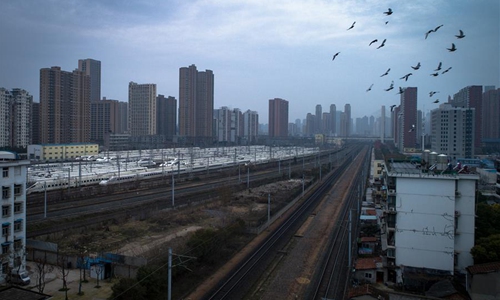HOME >> CHINA,SPECIAL-COVERAGE
China's environmental monitor refutes rumor claiming coronavirus cremations in Wuhan increase SO2
By Shan Jie Source:Global Times Published: 2020/2/12 17:08:40

Aerial photo taken on Feb. 10, 2020 shows the parked trains in Wuhan, central China's Hubei Province. (Xinhua/Xiao Yijiu)
There has not been an abnormal rise in (Sulfur oxide) SO2 density in recent days in Wuhan, the epicenter of the novel coronavirus outbreak, a Chinese environmental monitor said on Wednesday, refuting some recent reports saying that the burning of a large number of bodies has raised SO2 emissions to alarming levels.
"After careful confirmation, we found that the SO2 rise published by Windy.com was a 'serious distortion' and its statistics could not be trusted," according to a statement from the China National Environmental Monitoring Centre (CNEMC) sent to the Global Times via the Ministry of Ecology and Environment (MEE) on Wednesday.
The Daily Mail reported Sunday that Czech-based weather service Windy.com showed that SO2 levels in Wuhan reached 1,350 micrograms per cubic meter over the weekend. The report implied the rise was due to "a high number of cremations in the city."
According to the CNEMC statement, its monitoring stations in Wuhan city, Central China's Hubei Province, recorded that the SO2 intensity was 4-8 micrograms per cubic meter (μg/m3) between 12.00am and 1 am on Sunday, while the data published on Windy.com said it was around 1,500 and even up to 1,700 micrograms per cubic meter.
CNEMC indicated that data in other cities, such as Beijing, provided in windy.com also deviated greatly from the facts.
Data on SO2 based on the Sentinel-5P/TROPOMI satellite also suggested that between February 3 and 9, the SO2 intensity in Wuhan and surrounding areas remained low. The highest reading was only 11.5 micrograms per cubic meter on February 4, according to the CNEMC statement.
CNEMC worked with experts from the Center for Satellite Application on Ecology and Environment under China's environment ministry and Chinese Academy of Sciences to check the monitoring statistics.
CNEMC noted that the SO2 intensity statistics published by Windy.com had not been confirmed with ground monitoring, rendering it invalid.
CNEMC's monitoring measures are based on international standards, and the 1,436 automatic monitoring stations across the country are operated by third parties with no interference from authorities, according to the CNEMC statement.
Meanwhile, CNEMC also noted that air quality in Wuhan has remained generally stable since the Spring Festival in late January.
RELATED ARTICLES:
Posted in: SOCIETY,CHINA FOCUS